

 |
 |
|||||||
|
|
Posted courtesy of NewEnergyNews: By NewEnergyNews; Posted on: Monday, January 18, 2010 Buffalo Niagara: Where Industry Creates Energy; A comprehensive report on the green economy & Western New York's alternative-energy manufacturing potential SUMMARY The New Energy economy is bringing people together. Groups of counties with overlapping resources and markets in common are coming together in regional coalitions to facilitate broader based growth. Later this week, NewEnergyNews will profile the pioneering Green Coast Innovation Zone emerging in a tri-county region on California's central coast. Buffalo Niagara: Where Industry Creates Energy; A comprehensive report on the green economy & Western New York's alternative-energy manufacturing potential describes the enormous potential in an 8-county region of Western New York state where business and community leaders want to use the powerful viability of New Energy and Energy Efficiency to turn around the decaying economy of a once-vibrant manufacturing region. 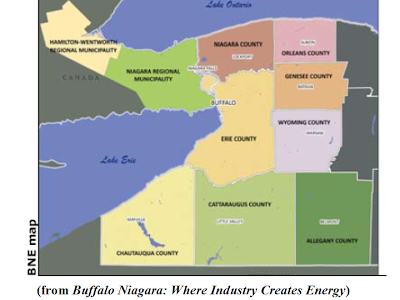 Regional collaboration offers the opportunity of expanded economic development through linkages and synergies between clusters of research & development, manufacturing and production, distribution service and support businesses throughout a region. Case in point: When National Grid paid for KWR International to run the numbers, theydiscovered the pooled potential in the Buffalo-Niagara area of Western New York state (the state's 8 westernmost counties: Allegany, Chautauqua, Cattaraugus, Erie, Genesee, Niagara, Orleans and Wyoming) is enormous. It is, first and foremost, manufacturing potential. The value chain of New Energy has a virtually shovel-ready manufacturing hub in the decaying infrastructure and under-utilized blue collar workforce of the Buffalo Niagara region. The federal government, as part of the Recovery Act, is already investing in manufacturing infrastructure and emphasizing manufacturing job growth and there is every justification for Buffalo Niagara to be a part of that economic redevelopment. But 2 years of marketing surveys and research by KWR International suggest the regeneration of the region as a manufacturing hub for New Energy (NE) and Energy Efficiency (EE) technology can be accompanied by a restored capacity for domestic, emissions-free energy generation that will thereby regenerate a long list of local economies. The region is rich in wind and has substantial solar distributed generation potential. In addition, it has barely begun to discover its hydrokinetic, geothermal, biomass and biofuels resources, all of which can be produced locally, therein supplying opportunities for local manufacturing, production and support services. The report suggests that Buffalo Niagara's success will require 4 major undertakings:
The study points the way. The question remaining is whether the region's leadership can turn the very real and substantive potential it defines into dollars and cents in the forms of economic growth and job opportunity. That is the human factor. 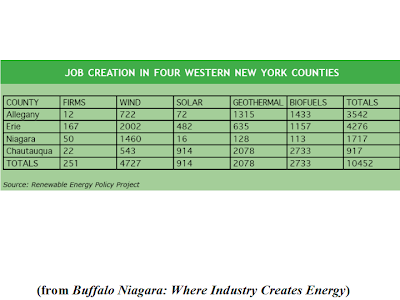 COMMENTARY Buffalo Niagara's political bent in not toward tree huggers but the logic of the New Energy economy is compelling, especially during a recessionary period. Even for those who reject the climate change issue, the opportunity to grow jobs and create revenues by moving to free, domestic sources of electricity generation and away from price-volatile fossil fuels is undeniably attractive. Governments from Beijing and Mumbai to Washington, D.C., are adding to the attraction with big stimulus money that is leveraging private spending. 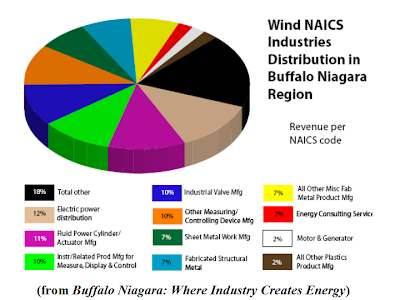 Regarding Green Jobs: The report cites a University of California-Berkeley review of 13 studies that found that NE and EE create twice the jobs per unit of energy and per dollar invested than Old Energy technologies. Example: The manufacture, marketing and deployment of utility-scale wind turbines employs sheet metal workers, machinists, engineers, mechanics, welders, millwrights, construction workers, sales, management, administrative and maintenance people. The report also points out that energy price volatility inclines consumers to efficiency, which employs new construction and retrofit workers, including architects, engineers, roofers, insulators, carpenters, inspectors, truck drivers and other support service personnel. These 2 groups are a profile of the unemployed and underemployed workforce of the Buffalo Niagara region. The Obama administration's 2009 budget allotted $150 billion for the NE and EE sectors to create or retain 5 million "green" jobs. 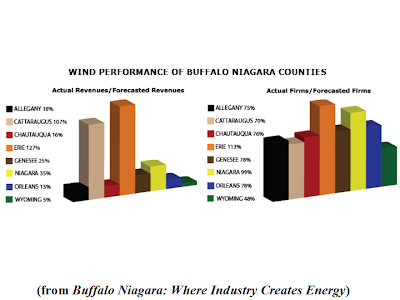 The 5 leading sectors in the New Energy part: (1) Wind, (2) Solar, (3) Hydropower, (4) Geothermal (for electricity generation), and (5) Biomass (for electricity generation and alternative liquid fuels). Non-energy-generating New Energy sectors include: (1) Energy Transmission and Storage, (2) Green Building, (3) Transportation (non-petroleum fuels), and (4) Waste Remediation and Recycling. The report also includes a consideration of nuclear energy. 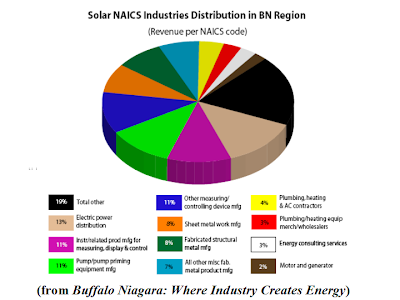 Buffalo Niagara's potential role in the supply chain for the New Energy economy includes:
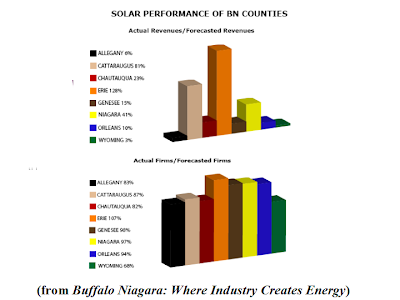 Buffalo Niagara's potential role in energy generation for the New Energy economy includes:
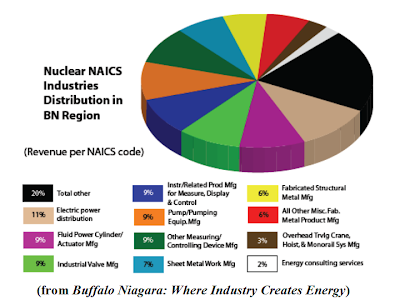 Business advantages to the Buffalo Niagara region: (1) Access to population centers, (2) proximity to Canadian areas with established New Energy initiatives and incentives, (3) adjacency to Great Lakes shipping ports, (4) established transportation infrastructure, (5) established manufacturing facilities, (6) trained and disciplined blue collar work force and (7) the University of Buffalo School of Engineering. The diversity of the area suggests it as a place that could nurture NE and EE companies and serve them as an ideal laboratory and launching ground for new processes and new products. Using 10 North American Industry Classification System (NAICS) industry sector classification codes, the report demonstrated the Buffalo Niagara region's unique revenue-generating diversity. 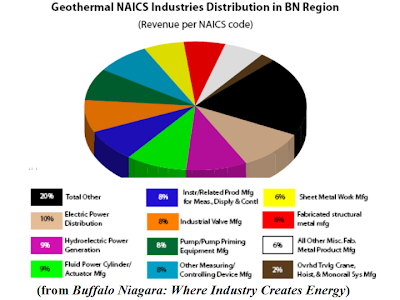 Larger markets, where more manufacturing industrial capacity and ancillary services would be expected, proved much less diverse. In Dallas, two NAICS codes in Waste Management generate 57.4% of revenues. In Los Angeles, four codes in Energy Transmission and Storage generate 66.5% of revenues. In Buffalo Niagara, most NAICS codes generate no more than 12% of revenues and only one of the 10 sectors (Electric Power Generation/Energy Transmission and Storage) accounted for as much as 14.1% of the region's revenues. This potential large and diverse manufacturing base is expected to emerge from the current recession with greater prestige as the nation rediscovers the urgency of energy self-reliance and the capacity to make things rather than perform financial services. Buffalo Niagara has the potential to be a model for the re-industrialization of the nation, driven by the emergence of the New Energy economy. This is the implication of the report's title phrase "Where Industry Creates Energy." 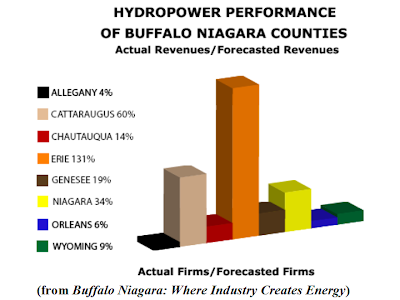 But companies will not simply be inspired by the vision and move to the region to build and retrofit facilities. It will require "substantial, proactive and concerted effort and leadership by business, government and academia on local, state and national levels." It will also necessitate the strategic development of business, financial, leadership and policy networks throughout the 8-county region. It will require the mitigation of traditional New York state obstacles to new business, including high taxes and fees, complicated bureaucracy, laws and regulations and – perhaps most importantly – the extension of New York state incentives for New Energy and Energy Efficiency to the NE and EE manufacturing value chain base. A starting point could be a marketing effort to create a "greener image" for the region to catch the interest of investors and entrepreneurs. 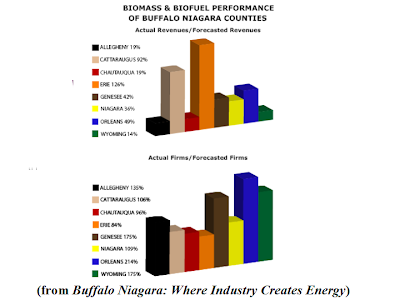 Local special incentives and development programs could begin to compensate for state program failings. Building codes more nurturing to NE and EE improvements could contribute to momentum. Tolerance of a more active and enthusiastic environmental community would also contribute to an image makeover. 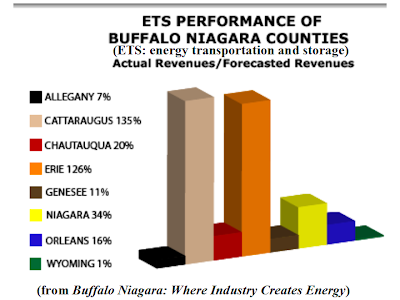 The report suggests that Buffalo Niagara's success will require 4 major undertakings:
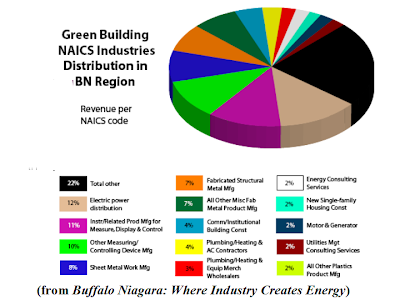 The report suggests that Buffalo Niagara's success will require several further undertakings:
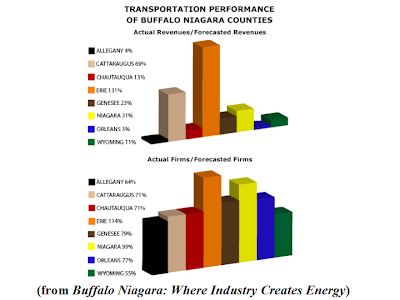 Goal: Build on the same strengths and attributes that made the region a powerhouse of industrial growth in the last century: (1) access to water and hydroelectric power, (2) a strategic position between the Northeast and Midwest and near Canada, (3) a skilled workforce, (4) established manufacturing capacity and industrial real estate. The payoff: Businesses, manufacturing, jobs and economic growth in coming decades. It will take united and coordinated action from the region's leadership but the payback potential is enormous. 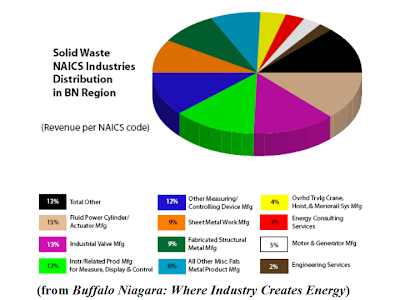 QUOTES - Keith W. Rabin, President, KWR/report lead analyst & project director: "The new green economy offers Buffalo Niagara unique job-growth opportunities as alternative-energy demand grows…This potential stems from its ability to provide manufacturing capacity in almost all alternative-energy sectors as a result of a more diverse and balanced industrial base than competing regions across the North America…" 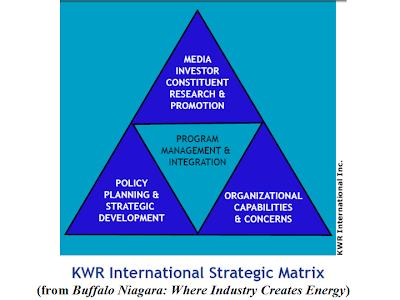 - From the Center for American Progress think tank, quoted in the report: "These jobs are impossible to offshore. Making buildings more energy efficient, constructing mass transit lines, installing solar panels and wind turbines, expanding public green space, growing and refining biofuels—all this work must take place right here in America, in both urban and rural areas." From the report: "The key job-creation opportunities for the region are found in the supply and value chain of all renewable energy sectors. In fact, it is the region's unique ability to participate in the development, design and manufacture of component parts across all sectors that gives it a potential competitive edge in attracting green economy jobs."  - From the report: "The uniqueness and potential of Buffalo Niagara in renewable energy rests far more with its ability to provide credible capacity across all the sectors examined in this report rather than any individual area or sub-sector. This is not to suggest the region does not have areas of relative strength, such as hydropower, given the existence of Niagara Falls; solar, with the subsidized supply of high-grade silicon from Globe Metals and industrial gases and other essential resources from local suppliers; or wind, due to the existence of Steel Winds and related industrial and metals-related firms. Rather, it is to recognize the future of renewable energy will stem from an ability to mix and match utilization between different sectors within an upgraded grid. Furthermore, a multitude of locations can demonstrate strength within individual sectors but few can demonstrate the same across-the board competitiveness as Buffalo Niagara. This would appear to be, not only its primary area of strength, but a basis for enhanced growth and profitability, as well aswider participation across this emerging field." Website content © KWR International |